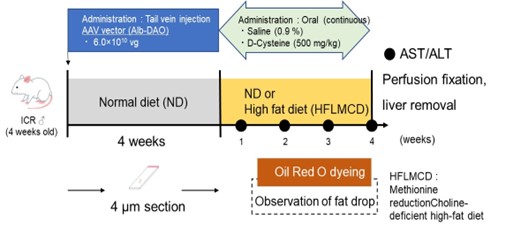Advantages
- Solutions to areas of global prevalence of 25% with no specific treatment
- Approach with amino acid which has established mass production and high solubility
- Confirmed that the concentration of 500 mg/kg shows an inhibitory effect
Current Stage & Goals
Data
Effects of D-Cysteine in a mouse model of NAFLD expressing hepatic DAO
 |
Since DAO is expressed in the liver in humans but not in mice (except in the kidney and cerebellum), an adeno-associated viral (AAV) vector that selectively expresses DAO in the liver was injected into the target mice via the tail vein to create the same conditions as in humans. After 4 weeks, we confirmed that DAO was expressed in the livers of mice injected with DAO-expressing AAV vectors but was not expressed in the livers of control mice. Thereafter, these mice were fed a normal or high-fat diet, while D-Cysteine or saline was orally administered every day for 4 weeks. During this period, blood samples were drawn weekly to measure AST and ALT levels.
 |
Chronic administration of D-Cysteine suppressed the elevation of AST and ALT in the high-fat low-methionine choline diet (HFLMCD) group.
D-Cysteine significantly suppressed AST from the second week onward and ALT from the third week onward.
Patent
Pending (unpublished)
Applicant
National University Kumamoto University
Researcher
Himeji Dokkyo University Department of Pharmacology, Faculty of Pharmaceutical Sciences
Professor Takahiro Seki
Development Phase
This stage : Proof of concept for NAFLD suppression effect by D-Cysteine is completed
Next stage :
1) Mechanism research, Development drug optimization
2) Clinical development
We are looking for partner companies interested in commercialization or in collaborations about this NAFLD drug. We would be happy to start with a detailed explanation and discussion of the technology.
Project No.ON-04751



